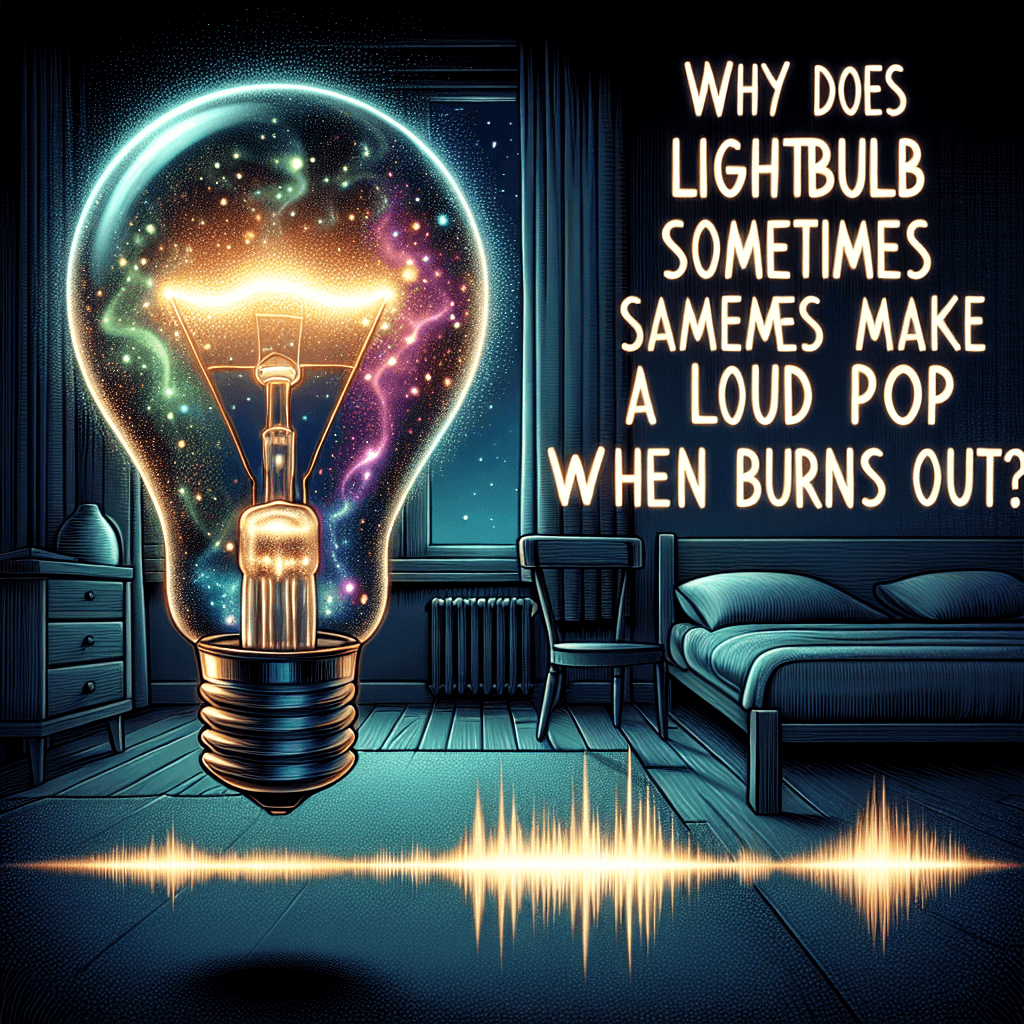Why does a lightbulb sometimes make a loud pop when it burns out
That startling POP isn't just a bulb burning out—it's a miniature explosion happening right over your head, and the science behind it is fascinating.


Too Long; Didn't Read
When the filament snaps, it creates a tiny electrical arc. This arc vaporizes the metal, causing a mini-explosion inside the bulb that you hear as a pop.
The Final Flash: Why Does a Lightbulb Sometimes Make a Loud Pop When It Burns Out?
It's a sound that can make you jump—a sudden, sharp pop from a lamp, followed by darkness. While most lightbulbs gracefully fade away, some end their life with a startling bang. This isn't just a dramatic exit; it's a fascinating display of physics happening in a split second. If you've ever wondered about the science behind this miniature explosion, you're not alone. This post will illuminate the precise reasons why a lightbulb sometimes makes a loud pop when it burns out, transforming a common household occurrence into an understandable scientific event. We'll break down the anatomy of a bulb, explore its two very different failure modes, and explain the powerful forces at play during its final, noisy moments.
The Inner Workings of a Classic Lightbulb
Before we can understand why a bulb pops, we need to know how it works. The traditional incandescent lightbulb, the kind most prone to this phenomenon, is a simple yet elegant piece of technology.
- The Glass Envelope: This is the outer glass shell, which is filled with an inert gas like argon or nitrogen.
- The Filament: The star of the show is a tiny, coiled wire made of tungsten.
- The Inert Gas: This gas is crucial. If the hot tungsten filament were exposed to oxygen, it would instantly oxidize and disintegrate. The inert gas creates a protective atmosphere, allowing the filament to glow for hundreds or thousands of hours.
When you flip the switch, electricity flows through the tungsten filament, heating it to over 4,000°F (about 2,200°C). At this extreme temperature, the filament glows intensely, producing light in a process called incandescence.
A Tale of Two Endings: The Quiet Fade vs. The Loud Pop
A lightbulb's life ends when its filament breaks, creating an open circuit and stopping the flow of electricity. However, how that filament breaks determines whether the bulb's end is silent or explosive.
The Most Common Scenario: The Quiet Burnout
Over its lifespan, the intense heat causes the tungsten filament to slowly evaporate. Tiny particles of tungsten break away and deposit on the inside of the glass, which is why old bulbs sometimes have a dark, greyish appearance. This process gradually thins the filament in certain spots. Eventually, one of these thin spots becomes too weak to handle the electrical current and simply breaks. The circuit is cut, the light goes out, and the event is completely silent. This is the most common way a lightbulb dies.
The Dramatic Finale: The Violent Arc
The loud pop occurs under a specific and more violent set of circumstances. It all starts the same way, with the filament thinning over time. But instead of snapping cleanly, a tiny gap forms while the electrical current is still trying to flow.
Here’s the step-by-step breakdown of the "pop":
- A Gap is Formed: As the filament nears its breaking point, a microscopic gap opens up.
- The Electrical Arc: The voltage is strong enough to "jump" across this tiny gap, creating a powerful electrical arc. This arc is essentially a small, contained bolt of lightning.
- A Massive Power Surge: This arc creates a near-perfect short circuit. For a fraction of a second, the bulb draws a huge surge of current from your home's wiring—far more than it was designed to handle.
- The Flash and Pop: This immense energy surge has two immediate effects. First, the arc's intense heat instantly vaporizes the remaining tungsten filament in a brilliant, blue-white flash. Second, this burst of energy superheats the inert gas inside the bulb, causing it to expand with explosive speed. The loud pop you hear is the sound wave from this rapid gas expansion pushing against the glass envelope. In some cases, the pressure is enough to crack or even shatter the glass.
This entire sequence, from the arc forming to the final pop, happens in milliseconds. Often, this power surge is enough to trip your home's circuit breaker or blow a fuse, which is a safety mechanism designed to prevent damage from such events.
Is a Popping Lightbulb Dangerous?
For the most part, a popping lightbulb is more startling than dangerous. The pop is contained within the bulb, and your home's electrical system is designed to cut the power. However, you should take care when removing a bulb that has popped, as the glass may be weakened or broken. It's always a good idea to turn off the light switch and let the bulb cool down completely before attempting to change it. This phenomenon is almost exclusive to incandescent and halogen bulbs; modern LEDs and CFLs fail in entirely different, and much quieter, ways.
Conclusion
So, the next time you're startled by a lightbulb popping, you'll know exactly what happened. It wasn't just a simple burnout; it was the grand finale of a powerful electrical arc. This arc created a massive current surge, vaporizing the filament in a bright flash and causing the internal gas to expand explosively. While this dramatic end is becoming less common as we transition to more modern lighting technologies like LEDs, it remains a perfect example of the fascinating physics at work in everyday objects around us. It’s a powerful reminder that even the most mundane items have a complex story to tell.
More Articles

Why is it safe to eat the mold in blue cheese but not on bread?
One mold is a carefully cultivated delicacy, while its cousin on your bread is growing dangerous, invisible toxins—we'll break down the crucial difference.

Why does fresh pineapple prevent gelatin desserts from becoming solid?
It's not a kitchen mistake; it's a case of culinary sabotage at the molecular level. Discover the powerful, protein-devouring enzyme in fresh pineapple that's actively digesting your dessert before it can even set.

Why are some ships deliberately fitted with metal blocks that are designed to be destroyed?
It sounds like madness, but these humble metal blocks are designed with a single, vital mission: to sacrifice themselves to the sea, preventing the ship's massive hull from being eaten alive.